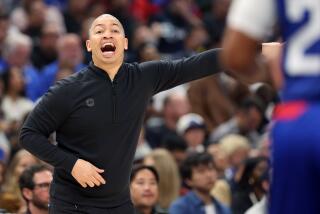Clippers Up in Air on Facility Selection : NBA: Owner Sterling misses self-imposed deadline. Problems with Burbank site and plans to renovate Sports Arena fuel speculation that Anaheim could lure team.
- Share via
Caught between two trouble-plagued alternatives, the owner of the Los Angeles Clippers has missed a self-imposed year-end deadline to choose a site for construction of a 20,000-seat, $100-million arena for his team.
Owner Donald Sterling intended to select a site by the end of 1992, one of the team’s executive vice presidents, Harley Frankel, said in April.
But as 1993 begins, Frankel is on a leave of absence to help with the Clinton Administration transition, and team officials say it is going to be at least several months before any decision is made.
There are problems with each of the main proposed alternatives: an entirely new facility in Burbank or a massive reconstruction of the Sports Arena, where the Clippers play now. Although the Clippers have steadfastly denied contemplating a move out of Los Angeles County, the site selection delay--coupled with an expected June completion of a $103-million indoor arena in Anaheim--conceivably could give Orange County a chance to win the franchise.
Andrew Roeser, the other Clipper executive vice president, quickly dismissed such speculation. “Donald Sterling believes his team belongs in Los Angeles,” Roeser said. The general manager of the Anaheim arena, Brad Mayne, added, “We’ve not had any discussions with the Clippers over the past several months.”
Obstacles aside, some suggested the Clippers were simply dragging their feet. One sports executive who has closely followed Sterling’s explorations said, “I believe they’re no closer to a decision now than they were last April.”
Team spokesman Mike Williams disagreed. “We’ve made major design strides,” he said. “We’ve prepared schematic drawings in great detail for both Burbank and the Sports Arena.”
Roeser made it clear that the Clippers are impatient with having to play in the existing Sports Arena, which they believe is far inferior to most other facilities in the National Basketball Assn.
“The capacity of the Sports Arena (15,989 for basketball) is low by NBA standards today,” Roeser said. “It’s dingy. There is little quality seating at the lower levels. It doesn’t have other amenities. The accessibility and the flow of the parking is not up to par. There is no quality restaurant.
“All these are problems that could be fixed,” Roeser said. But he acknowledged that the political climate does not favor a decision to proceed with a reconstructed Sports Arena until after the Los Angeles municipal election this spring. The election may lead to the appointment of new members to the Coliseum Commission, which administers the facility.
Efforts to renovate the Sports Arena have foundered for years due to chronic indecision and a lack of financial resources.
In the meantime, new or reconstructed facilities have been provided NBA franchises in 10 cities across the country, and four new arenas are on the drawing boards, Roeser said.
Across town in Burbank, Roeser said, there are impediments to building an arena on a site between the airport and the downtown business district.
One obstacle is the need for a toxic cleanup at the site, which once belonged to the Lockheed Corp. There have also been problems with securing investors. And there is the possibility that, because of an environmental impact report and other preparations, it could take longer to build a new facility in Burbank than to refurbish the Sports Arena, he said.
But again, Roeser downplayed the troubles. “It’s nothing that money can’t solve,” he said. “Actually, the reason for going or not going anywhere has less to do with the environmental impact report and toxins and more to do with what’s the best location to attract our fans.”
The Clippers, he said, now draw about 30% of their fans from the San Fernando Valley, about 60% from other parts of Los Angeles County and about 10% from Orange County. The team is doing market research to determine where its best location would be, he said.
A third alternative under consideration is building on a site to the north or east of the expanded Los Angeles Civic Center.
Roeser acknowledged that the poor Los Angeles economy was “a consideration” in Sterling’s stalled efforts to reach a decision.
But, he added, “It also may be an opportunity. It’s while an economy is down that things can be built, and by the time you’re ready to open them, the economy is turning up.
“But certainly the economy has got to be a factor. It’s not the ‘80s. The building we build will be for the ‘90s, and we have to go where the people are.”
That’s what gives Anaheim some encouragement, despite the Clipper statements about staying in Los Angeles County.
“When you take into consideration (the fact that by) combining Orange and Riverside counties, and drawing a 25-mile radius around the Anaheim area, (and) not even including people in the Los Angeles area, you have 5 million people,” said Mayne, the Anaheim facility’s general manager. “So we’re very confident that an NBA franchise will locate in Anaheim. And remember, our stadium will be ready this year.”
The Anaheim facility recently secured a National Hockey League franchise being organized by the Disney Corp.
As for Burbank, developer Lew Wolff--who last year was awarded exclusive rights for three years by the Burbank City Council to negotiate for construction of an indoor arena in the city--said he would not mind a delay of three to six months in the Clippers’ choice.
Wolff confirmed difficulties in arranging financing. He said that Warner Bros.--which has been delaying a decision on whether to join Wolff and his partner, actor Wayne Rogers, in building the Burbank arena--”has not made a concrete decision to do this.”
As for toxics considerations, Wolff said, “There is a cleanup problem, but it’s a manageable one.”
“I think a move to Burbank by the Clippers will be a difficult, emotional decision,” Wolff added. “Whatever fan base they have is used to going to the Sports Arena.”
At the Sports Arena, a representative of the facility’s management said that the Coliseum Commission recently authorized $500,000 to draw up initial plans for a reconstructed facility.
“If you look at this site, it has advantages,” said Peter Luucko, representing the Spectacor partnership. But despite the appropriation, he conceded that it would take at least “two or three years to get (the new facility) done.”
Roeser, meanwhile, contended that the Coliseum Commission seems less interested in pleasing the Clippers than in accommodating Los Angeles Raiders owner Al Davis by renovating the adjacent Coliseum.
With so many uncertainties at the prime sites, it is not surprising that Anaheim officials quietly observe that they are keeping the door open there.
More to Read
Get our high school sports newsletter
Prep Rally is devoted to the SoCal high school sports experience, bringing you scores, stories and a behind-the-scenes look at what makes prep sports so popular.
You may occasionally receive promotional content from the Los Angeles Times.






